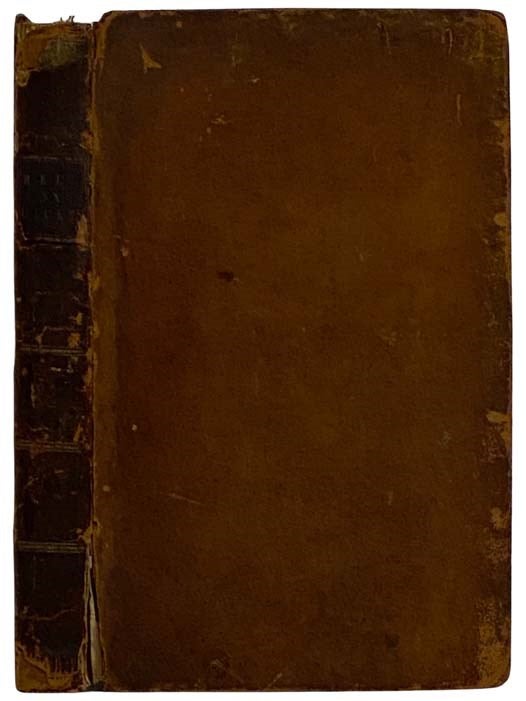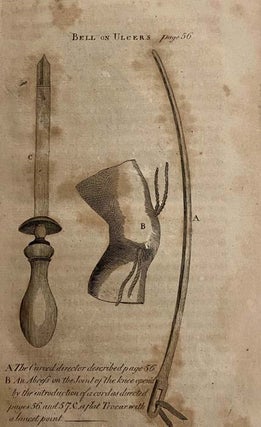A Treatise on the Theory and Management of Ulcers: with a Dissertation on White Swellings of the Joints, to which is prefixed, an Essay on the Chirurgical Treatment of Inflammation and Its Consequences.
Boston: I. Thomas and E.T. Andrews, 1791. First American Edition. Full-Leather. Good / No Jacket. Item #2326469
First American edition of Garrison-Morton 5578. Evans 23171. Joints split but holding, edges rubbed with corners exposed and some loss from spine head and foot, ink name and date (Joseph Torrey 1791) on front endpaper.
xv, 295 pp. Full leather, leather spine label with gilt titles and rules. Includes one engraved plate showing two surgical tools and an abscess of the knee joint. Author's first book. Bell was surgeon to the Royal Infirmary in Edinburgh for 29 years, and his contribution to the study of ulcers was significant. He made other advances to medical knowledge as well: he was the first to differentiate between gonorrhea and syphilis, and improved the methods of amputation with his 'triple incision' technique. Both Garrison-Morton and the Oxford Dictionary of National Biography (ODNB) characterize his 1783-8 six-volume work on surgery as his best work, but calls this work an "[i]mportant classification of ulcers." "Bell, Benjamin (1749–1806), surgeon and farmer, eldest son of the fifteen children of George Bell (1722–1813), farmer, and Anne, née Corrie, of Speddoch, was born at Dumfries in April 1749. He was descended from landed proprietors of long standing in Dumfriesshire. Subsequently the family moved to Woodhouselees, Canonbie, in Eskdale, about a mile from the border with England, where George Bell was considered 'one of the best improvers of the land in the district in which he lived' (Bell, Essays, X). Benjamin Bell was educated at Dumfries grammar school, and in 1764 was apprenticed to James Hill, surgeon, of Dumfries. In 1766 he entered the Edinburgh medical school, where Monro primus and secundus, Joseph Black, and John Gregory were among his teachers. House surgeon to the Royal Infirmary, he became fellow of the College of Surgeons of Edinburgh in 1770, and then studied surgery in London and Paris for almost two years, being appointed surgeon to the Royal Infirmary, Edinburgh, in August 1772. About 1776 he married Grizel, daughter of Robert Hamilton DD, with whom he had a numerous family which included George Bell (1777–1832), a well-known surgeon; a grandson, Benjamin Bell (1810–1883), was also a surgeon and wrote a biography of his grandfather. Shortly after his marriage Bell sustained a severe injury in falling from a horse and gave up practice for two years to settle on a farm near Edinburgh, where his family lived from spring to autumn of every year. There he developed a profound interest in agriculture; later he was to occupy another farm, near Melrose Abbey. His earliest writings on agriculture appeared in 1783. Bell's first book, A Treatise on the Theory and Management of Ulcers, published in 1778, attracted considerable attention, achieved a seventh edition in 1801, and was translated into French, Italian, Spanish, Portuguese, and German. His most important work, A System of Surgery, illustrated with ninety-nine plates of instruments and equipment, appeared in six volumes between 1783 and 1788; it too reached a seventh edition in 1801, and was translated into Italian, French, Spanish, and German, despite criticisms from John Bell and Benjamin Brodie. In this textbook Bell proposed methods of reducing pain and of conserving skin during operations by careful techniques; he discouraged the proliferation of instruments, yet illustrated many new items from Europe and some of his own, which had been refined by extensive experience. James Wardrop wrote: 'He was a successful operator, and during many years, was more employed than any other surgeon in Scotland' (Bell, Life, 112). However, Bell led an arduous life, with many night journeys to visit distant patients in Scotland and northern England. Accumulating money, he purchased extensive estates near Jedburgh and near Melrose, and in Newington, Edinburgh. But his health suffered and periodically he stopped work to recuperate in southern England, where he also took note of local methods of agriculture. These breaks provided the opportunity to write, and in 1793 he published A Treatise on Gonorrhoea virulenta and Lues venerea in two volumes, which achieved three editions and was translated into Italian, Spanish, and French. Bell defined these venereal infections as separate diseases at a time when many, including John Hunter, believed that they were related. In 1794 he published A Treatise on the Hydrocele, on Sarcocele, or Cancer, and other Diseases of the Testis; no further editions appeared. Bell, who was concerned that agricultural production was not keeping pace with population growth, also wrote essays on taxation, the national debt, the corn laws, and agricultural reform. These were collected and published in 1802 as Essays on agriculture, with a plan for the speedy and general improvement of the land in Great Britain. Bell's conclusions were commended by Adam Smith." - ODNB
Price: $325.00


